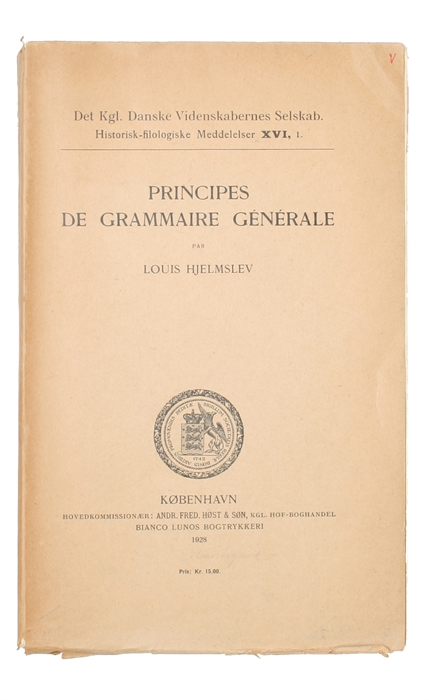THE STARTING POINT OF LINGUISTIC ANALYSIS
HJELMSLEV, LOUIS.
Omkring Sprogteoriens Grundlæggelse. [Prolegomena to a Theory of Language].
København [Copenhagen], 1943. Lex8vo. Uncut in the original printed wrappers. Spine and part of back wrapper faded, otherwise very nice and clean. 116 pp.
The seminal first edition of this breakthrough work in linguistics, which constitutes the basis of linguistic analysis and served as a main inspiration for Derrida's "De la Grammatologie".
In 1943 the first edition of the main work of the great Danish linguist Louis Hjelmslev (1899-1965) appeared. The work appeared in the series "Festskrift udgivet af Københavns Universitet i Anledning af Universitetets Aarsfest" and bore the title "Omkring Sprogteoriens Grundlæggelse". The work was translated into English as "Prolegomena to a Theory of Language" and later into French as "Prolegomenes a une theorie du langage ". This work came to represent a breakthrough in linguistics and formed an entirely new branch of this field.
Hjelmslev had studied comparatvive linguistics in Copenhagen, Prague and Paris, when in 1931 he co-founded the "Cercle Linguistique de Copenhague", also known as the "Copenhagen School of Linguistics" with Viggo Brøndal (1887-1942). Hjelmslev's linguistic theories formed the basis of this seminal scool, which soon became one of the most important centres of structuralism in the world. The single most important cornerstone of this internationally highly influential school was the new theory on language that Hjelmslev had developed together with Hans-Jørgen Uldall. This theory consisted in the double duality of the linguistic sign and is now known as "Glossematics", a now generally used term, which was coined by the two. "Glossematics" represents an attempt to analyze the contents and the form of language on a coherent basis. Hjelmslev's theories of semiotics became hugely influential, and virtually all of the greatest European thinkers interested in language and theories of language throughout the 30s, 40s, 50s, 60s and 70s were hugely inflenced by Hjemslev, whose theories remain of seminal character to this day.
In his main work, "Prolegomena to a Theory of Language", Hjelmslev begins by ascertaining that "- Language - human speech - is an inexhaustible wealth of manifold values. Language is inseparably linked to man and follows him in all of his doing. Language is the tool with which man moulds thought and feeling, mood, aspiring, will and action, the tool with which he influences and is influenced, the last and deepest condition of human society. [...]" ("- Sproget - mennesketalen - er en uudtømmelig rigdom af mangfoldige værdier. Sproget er uadskillelig knyttet til mennesket og følger ham I al hans færd. Sproget er det redskab hvormed mennesket former tanke og følelse, stemning, stræben, vilje og handling, det redskab hvormad han paavirker og paavirkes, menneskesamfundets sidste og dybeste forudsætning." p. (5) ). He then goes on to unfold a criticism of the linguistic methodologies in use at the time. He accepts Saussure's theories of language as a system of signs, the leading theories in this field at the time, but he claims that this only applies to theories of language use. Hjelmslev, however, wishes to establish a regular linguistic system, in which language is seen as a complex system made up of small units. He sees earlier linguistic methodologies as being merely descriptive, and as the first, he wishes to provide a methodology that is systematizing and provide a linguistic theory that is to found the basis of a rational form of linguistics. The theory that Hjelmslev thus develops here came to constitute an important contribution to modern general epistemology, a contribution that likewise constitutes the starting point of linguistic analysis.
Linguistic analysis is set off with the theory propounded in this work that a sign not merely refers to one form, but to two, namely a content form and an expression form. At the same time, every function of a sign is twofold in that it is manifested by both the content substance and the expression substance, the first being the psychological manifestation of the sign, the second being the material substance, in which the sign is manifested.
Thus, Hjelmslev puts forth a new form of semiotics, one in which language and linguistics are not necessarily bound to a spoken language, and one which is constituted by a scientific method of analysis. Because of this theory, a new philosophical tradition also sees the light of day, one inspired by the opposition to the widely accepted idea that images, in order to be understood, had to be translated into a phonetic substance or something more concrete. For Hjelmslev, the linguist finds meaning in from the form of content, and it is from the point of view of this form that the content substance must be analyzed.
This theory deeply influenced both Deleuze, who often mentions Hjelmslev throughout his works, and Derrida, who's "Grammatologie" is deeply inspired by Hjelmslev's work, to which it bears numerous references and long quotations.
Order-nr.: 37432

